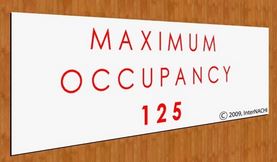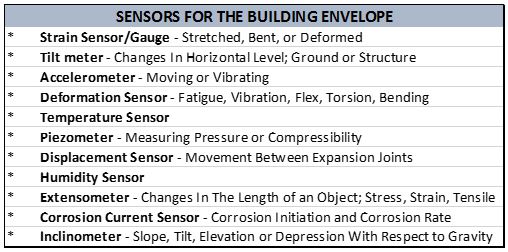|
January 2014
Article
AutomatedBuildings.com
|
[an error occurred while processing this directive]
(Click
Message to Learn More)
|
|
Smart Buildings Predictions for 2014
The next big leap will be the development of
software applications that not only can identify a system fault, but
can automatically correct it.
|

Jim
Sinopoli PE, LEED BD+C, RCCD
Managing
Principal,
Smart
Buildings LLC
Contributing Editor
|
 ALL DAY ALL SYSTEMS
ANALYTICS
ALL DAY ALL SYSTEMS
ANALYTICS
We all now know the
benefits of using analytic software applications to support the
operations of a building. Automatic Fault Detection and Diagnostics
(AFDD) routines have proven to save energy and support facility
management staff in ways that make operations more effective and
efficient. The primary focus of the analytic software has been HVAC
systems, and rightly so; it’s the most complex system in a building and
uses the most energy. The detection and monetization of faults and the
use of such software in re-commissioning buildings are all verified
positive results of analytic applications.
What will happen in 2014? There will be an upsurge of similar analytic
software for other building systems using AFDD as a template. The idea
of determining how a system should operate optimally, casting the ideal
routine into a set of software “rules”, and monitoring adherence to the
rules through real-time data points of the system will be applied to
almost every building control system.
The analytics will go beyond well running building systems to decision
making. An example would be a demand response event: in making a
decision on whether or how to respond one has to take into account
several financial and operational variables, including tangible and
intangible benefits and costs. How much load can I shed? How can I shed
it? What’s my typically demand profile during the timing and duration
of the event? Do I use auxiliary energy generation? What’s the
maximum demand I can curtail?
The next big leap will be the development of software applications that
not only can identify a system fault, but can automatically correct it.
This will be a level of sophistication with significant consequences
for building performance and be the largest impact on building
operations and performance in decades. If an airplane can flight
eight miles above the earth on “autopilot” why can’t a building on the
ground do so?
Photovoltaic
Windows
 Windows play critical role in dealing
with energy related thermal loads and lighting in building spaces. We
worry about the sun creating additional thermal load, but also the
“visual comfort” of the building space; brightness, glare and
shadows. In 2014 we’ll see more attention to shading devices,
glazing, electronic switchable windows and window related control
systems.
Windows play critical role in dealing
with energy related thermal loads and lighting in building spaces. We
worry about the sun creating additional thermal load, but also the
“visual comfort” of the building space; brightness, glare and
shadows. In 2014 we’ll see more attention to shading devices,
glazing, electronic switchable windows and window related control
systems.
There’s a move on to integrate photovoltaics into buildings rather than
having a separate solar array. That trend starts with windows. The big
break out in 2014 will be “solar panel windows”. Essentially
transparent photovoltaic windows will be utilized in buildings to
facilitate the structure as a solar collector.
The technology is in an early phase but shows tremendous potential.
Some of the current versions of photovoltaic windows can transmit more
than 70% of the visible light, similar to tinted glass windows already
in use. The power conversion for the initial designs is low but is
expected to improve and reach over 12% efficiency. One research team
calculated that even with 5% efficiency the windows could generate over
25% of the energy needs of a building. Besides energy generation, the
windows could also reduce infrared radiation, thus reducing thermal
loads.
Having windows generating DC power also begs the question of why not a
DC power infrastructure? The argument for DC infrastructure in
buildings is quite compelling. Most of our devices and equipment we use
operate internally on DC. Power storage is DC. Plus, eliminating the
conversion of AC to DC saves some energy. The market will move towards
interaction and integration between photovoltaic windows, DC current,
microgrids and power storage.
Real Occupancy
Metrics
 Facility managers know the value of
having accurate and timely occupancy data, but it is challenging to
generate that data. The options for acquiring occupancy data include
video surveillance, access cards, infrared, RFID and a host of other
methods. Each technical approach has its pros and cons. However, it now
seems the best approach to procure occupancy data will be through an
occupant’s smartphone; everyone’s onboard sensor system.
Facility managers know the value of
having accurate and timely occupancy data, but it is challenging to
generate that data. The options for acquiring occupancy data include
video surveillance, access cards, infrared, RFID and a host of other
methods. Each technical approach has its pros and cons. However, it now
seems the best approach to procure occupancy data will be through an
occupant’s smartphone; everyone’s onboard sensor system.
Last year one of our predictions featured Indoor Positioning Systems.
These systems are backed by many large international technology
companies including Google, Nokia, Samsung, etc. While there are
different ways of deploying the systems, many use the ubiquitous
smartphone to communicate with or acknowledge the phone via Wi-Fi or
Bluetooth. The major application for these systems from the technology
companies are related to way finding (i.e. taking Google maps or Map
Quest into buildings such as malls, airports and museums); as well as
identifying people via their smartphone and then relating the personal
identification to the surrounding space. For example, letting a person
know their favorite coffee shop is in a mall or a department store
recognizing a past customer and sending out a discount coupon to draw
the person back in to shop.
This technical approach can recognize an “occupant”. In 2014 you’ll see
large companies use the same technology in their own buildings with
their employee smartphones. Researchers have studied the tracking of
employees via their smartphones using the office Wi-Fi systems. While
the accuracy of Wi-Fi is not as good as “Bluetooth Beacons” for
identifying the exact locations, it’s still good enough to develop
occupancy metrics. The researchers created apps that could power down a
workspace when the occupants left and power it up as the occupant
approached or entered the space. One study estimated that energy for
lighting could be cut in half using the technology. Facility engineers
will be able to know how many people are in building spaces, the
duration of their stay, what areas are really being used, how best to
design or renovate spaces, linking the occupancy data into a host of
building control systems, etc.
STRUCTURAL MONITORING
You generally will not see the words “building automation” and
“building envelope” in the same sentence. In general, monitoring steel,
concrete and other inert materials may sound a bit ludicrous. Building
envelopes have several basic functions: they protect occupants from
adverse weather, let light into the building, they provide security and
safety, it’s a major component in occupants’ thermal comfort and the
air change rate, building envelopes provide some acoustic isolation,
and of course it provides the aesthetic attributes that occupants react
or relate to.
The envelope is critical for structural integrity, energy management,
maintenance, operations and security. Most monitoring of a building’s
envelope or structure is done through periodic manual inspections.
However, in 2014 we will see increased deployment of automated
monitoring of building envelopes, especially for new high rise and
skyscrapers in large urban areas.
[an error occurred while processing this directive]What could possibly be monitored in the building
envelope and related structure that would assist in measuring and
managing the building’s performance? Turns out there is plenty:
Moisture
Intrusion – If there’s moisture in the building envelope there’s
a leak possibly leading to mold and or a breach in the integrity of the
envelope. The solution is moisture sensors and a data recorder to
continuously monitor the envelope with sensors at locations such as
parapet joint flashing, control joints, wall-window interfaces, window
jambs, wall-concrete slab interfaces and all the other places water is
likely to gather, settle or get into.
Air Leakage
- Air leaking through a building envelope not only wastes a significant
amount of energy but it decreases thermal comfort for occupants, allows
dust, moisture, noise and airborne pollutants into the building.
Measuring air pressure differences via a remote instrument can at least
indicate potential issues that need to be further inspected via a
manual air leakage test.
Structural
Loads - Building structures should be monitored for stress,
strain, vibration, deflection, displacement and tilt, with the data
being analyzed to determine the integrity of the building structure.
One common building example is the steel joist construction used in
many commercial buildings to support the roof; the use of strain gauges
or sensors can assist the building owner in monitoring the load of the
roof when it snows or rains.
Seismic
Monitoring - Seismic monitoring is a highly specialized building
system. It uses accelerometers (devices that measure motion and
vibration) at specific locations throughout the building to measure the
response of the structure in an earthquake event. Seismic monitoring
has several critical benefits. For the building owner, real-time data
on how the event affected the structure is quicker and can assist in
the physical inspection of the building afterwards, thus increasing the
likelihood that the building can remain functional or quickly regain
functionality.
Openings in
the Structure - Fenestrations
The fenestrations of the envelope quite simply must be monitored. That
means each exterior door and operative window should have a switch in
its frame to indicate whether the door or the window is open or closed.
Doors that have access control already have such switches, but other
doors not covered by access control should have a door position switch
as well. If you have a facility or building management system
that can monitor the door or window position switches you can create
some “exceptions” or times as to when open doors or windows are
acceptable and when they’re not, thus reducing the number of false
alarms.

For more
information, write us at info@smart-buildings.com.
footer
[an error occurred while processing this directive]
[Click Banner To Learn More]
[Home Page] [The
Automator] [About] [Subscribe
] [Contact
Us]
